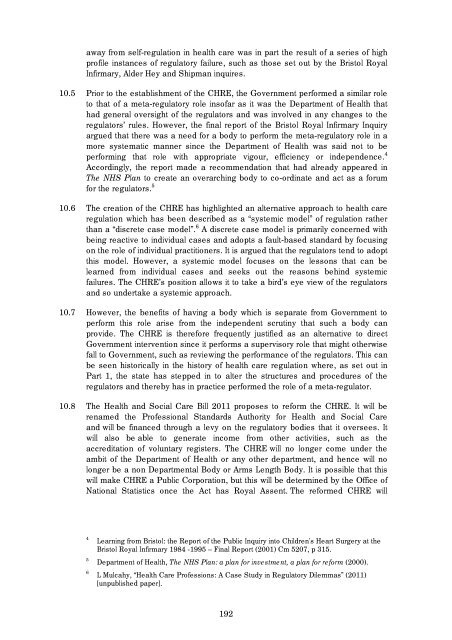Regulation of Health and Social Care Professionals Consultation
Regulation of Health and Social Care Professionals Consultation
Regulation of Health and Social Care Professionals Consultation
You also want an ePaper? Increase the reach of your titles
YUMPU automatically turns print PDFs into web optimized ePapers that Google loves.
away from self-regulation in health care was in part the result <strong>of</strong> a series <strong>of</strong> high<br />
pr<strong>of</strong>ile instances <strong>of</strong> regulatory failure, such as those set out by the Bristol Royal<br />
Infirmary, Alder Hey <strong>and</strong> Shipman inquires.<br />
10.5 Prior to the establishment <strong>of</strong> the CHRE, the Government performed a similar role<br />
to that <strong>of</strong> a meta-regulatory role ins<strong>of</strong>ar as it was the Department <strong>of</strong> <strong>Health</strong> that<br />
had general oversight <strong>of</strong> the regulators <strong>and</strong> was involved in any changes to the<br />
regulators’ rules. However, the final report <strong>of</strong> the Bristol Royal Infirmary Inquiry<br />
argued that there was a need for a body to perform the meta-regulatory role in a<br />
more systematic manner since the Department <strong>of</strong> <strong>Health</strong> was said not to be<br />
performing that role with appropriate vigour, efficiency or independence. 4<br />
Accordingly, the report made a recommendation that had already appeared in<br />
The NHS Plan to create an overarching body to co-ordinate <strong>and</strong> act as a forum<br />
for the regulators. 5<br />
10.6 The creation <strong>of</strong> the CHRE has highlighted an alternative approach to health care<br />
regulation which has been described as a “systemic model” <strong>of</strong> regulation rather<br />
than a “discrete case model”. 6 A discrete case model is primarily concerned with<br />
being reactive to individual cases <strong>and</strong> adopts a fault-based st<strong>and</strong>ard by focusing<br />
on the role <strong>of</strong> individual practitioners. It is argued that the regulators tend to adopt<br />
this model. However, a systemic model focuses on the lessons that can be<br />
learned from individual cases <strong>and</strong> seeks out the reasons behind systemic<br />
failures. The CHRE’s position allows it to take a bird’s eye view <strong>of</strong> the regulators<br />
<strong>and</strong> so undertake a systemic approach.<br />
10.7 However, the benefits <strong>of</strong> having a body which is separate from Government to<br />
perform this role arise from the independent scrutiny that such a body can<br />
provide. The CHRE is therefore frequently justified as an alternative to direct<br />
Government intervention since it performs a supervisory role that might otherwise<br />
fall to Government, such as reviewing the performance <strong>of</strong> the regulators. This can<br />
be seen historically in the history <strong>of</strong> health care regulation where, as set out in<br />
Part 1, the state has stepped in to alter the structures <strong>and</strong> procedures <strong>of</strong> the<br />
regulators <strong>and</strong> thereby has in practice performed the role <strong>of</strong> a meta-regulator.<br />
10.8 The <strong>Health</strong> <strong>and</strong> <strong>Social</strong> <strong>Care</strong> Bill 2011 proposes to reform the CHRE. It will be<br />
renamed the Pr<strong>of</strong>essional St<strong>and</strong>ards Authority for <strong>Health</strong> <strong>and</strong> <strong>Social</strong> <strong>Care</strong><br />
<strong>and</strong> will be financed through a levy on the regulatory bodies that it oversees. It<br />
will also be able to generate income from other activities, such as the<br />
accreditation <strong>of</strong> voluntary registers. The CHRE will no longer come under the<br />
ambit <strong>of</strong> the Department <strong>of</strong> <strong>Health</strong> or any other department, <strong>and</strong> hence will no<br />
longer be a non Departmental Body or Arms Length Body. It is possible that this<br />
will make CHRE a Public Corporation, but this will be determined by the Office <strong>of</strong><br />
National Statistics once the Act has Royal Assent. The reformed CHRE will<br />
4 Learning from Bristol: the Report <strong>of</strong> the Public Inquiry into Children's Heart Surgery at the<br />
Bristol Royal Infirmary 1984 -1995 – Final Report (2001) Cm 5207, p 315.<br />
5 Department <strong>of</strong> <strong>Health</strong>, The NHS Plan: a plan for investment, a plan for reform (2000).<br />
6<br />
L Mulcahy, “<strong>Health</strong> <strong>Care</strong> Pr<strong>of</strong>essions: A Case Study in Regulatory Dilemmas” (2011)<br />
[unpublished paper].<br />
192
















